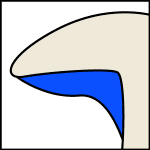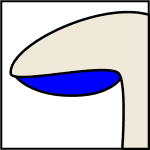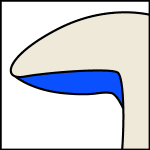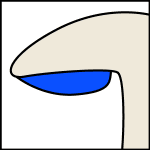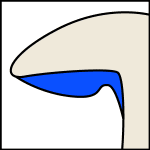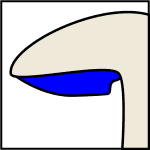How to Identify Mushrooms
Sometimes I’m out on a walk, walking the same route I have most mornings with my dog, yet suddenly I catch a white glimmer under one of the hedges. I lift up a bit of the hedge and, almost like Alice discovering wonderland, I see absolutely loads of mushrooms.
First thought! OMG, this is amazing they’re so big!
Second thought! Are they edible?
Third thought! How on earth am I supposed to identify this mushroom from the other 10,000 species?
I look in a full detailed guide to mushrooms and become bewildered with the sheer number of different types, looking at the pictures thinking “it looks like that mushroom” turn 10 pages “oh and it looks like that one” another 10 pages and “oh wait…. it looks like that one too” until I give up all hope.
Through this blog, I’m hoping to give you some great tips for the process of identifying mushrooms (at least down to its family before later deciding whether it’s even worth identifying it out further).
A foragers perspective on mushrooms is quite different from that of a mycologist; you will see mycology groups picking nearly one of every mushroom they find, looking at each in great detail, walking around with their little toolbox of tricks. However as a forager, there are quite literally thousands of mushrooms that I just don’t care about. Sure they may look nice, but I’m not even going to make the effort to bend down and take a closer look because I know it’s not worth my time. The time I could spend looking harder for the really good edibles. In fact, we even have an abbreviated term for these types of mushrooms – we call them LBJ’s – Little Brown Jobbies – there are thousands of them, firstly they’re usually too small for bothering with and they’re actually very difficult to identify without the use of a detailed microscope – and who just happens to have one of those lying around in their pockets whilst 3 hours into a walk.
I’ve met a number of mushroom hunters (typically from Nordic countries) who have grown up picking mushrooms and therefore have the knowledge of identification ingrained already. This is amazing to see and these people are fantastic to be around, however they’re really difficult to learn from. For example, you stumble across a mushroom –they’ll say “this is a Brown Rollrim “– I say “amazing, how do you know that and what are its key features” to the reply “well it just is” – I’d really struggle to identify this mushroom again without a serious breakdown of all of the key features I’m looking for.
I take a much more systematic approach to identify mushrooms now.
Top tips for identifying mushrooms:
-
What type of environment are you in?
What type of trees are surrounding you? Most mushrooms are associated with specific tree species whilst others are mainly found in open grassland. Understanding the environment you are in and the types of trees around you is a really important start to figuring out what mushroom you have.
-
Where are the mushrooms growing?
Is the mushroom growing from the ground, out of decaying wood, out of a living tree, out of another mushroom or is it even growing out of the head of a grub?
-
What’s the overall look of the mushroom?
When you get a little more used to mushrooms this stage can pull you to specific species straight away. Maybe the mushroom is found around the oak, actually growing off the wood of a living oak tree, it’s a vibrant yellow and fairly large – fantastic! you have Chicken of the Woods.
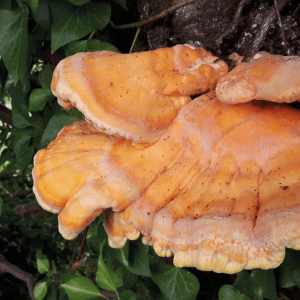
-
Does it leak milk when cracked?
Some mushrooms leak a type of milk when they’re cracked, these are in either the Lactarius or Mycena family and by cracking or snapping a bit of the mushroom you can tell if it does or doesn’t leak milk straight away. Usually, the milk is either white or orange.
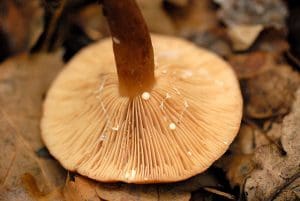
-
How do the gills connect to the stem?
This sounds a bit odd but how the gills connect to the stem or don’t connect to the stem is a really important feature for identifying mushrooms. These are given funny names – here’s a good example below. To see this more easily on the mushroom you have, simply slice it in half and look at the cross-section.
-
How do the gills run from the stem to the edge of the cap?
This typically happens in a couple of different ways with slight variants of each. To see this on a mushroom you sometimes have to look very close and a hand microscope can be useful to have on you when out fungi hunting.
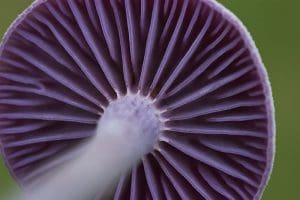
-
What’s the spore print?
A mushrooms way of reproducing is by dropping its spores (its version of seeds). They’re varying colours and this colour is again really important in helping to identify the mushroom. For example, the edible Honey fungus drops white spores and the none edible Scaly Cap drops brown (sometimes people confuse the two of these but a simple spore print would have sorted that issue). So how to do it? Simply take your mushroom and cut the stem off as close to the cap as possible. On a flat surface place two pieces of paper edge to edge, one black and one white. Put the mushroom cap, gill side down, on top of the paper so half is over the white paper and half over the black. Take a piece of kitchen roll and dampen it with some water (it doesn’t need to be drenched, just damp) put this over the top of the mushroom. The mushroom needs to be moist in order for it to drop its spores. Leave it 4 hours and return, if you pick up the mushroom and paper the spores should have dropped and have made a lovely spore print image on your paper. If the spores are light in colour they will show up on the black paper and if dark they will show up on the white paper.
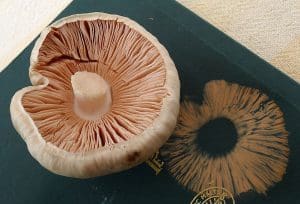
If you’re not used to mushrooms yet this is the stage at which I would advise turning to our first mushroom guide – “An initial guide to the identification of mushrooms and toadstools”. I use this book on every mushroom course I run, I’m always amazed by the results, I can get a group who know little about mushrooms to identify specific fungi down to its species within 30 minutes of the course beginning. It’s genuinely astonishing.
This guide works systematically through a range of keys allowing you to answer a range of questions that result in you discovering the family the mushroom is from.
Then to the next book to look up the family in more detail and we might get ourselves to the Winter Chanterelle or yellow legs.
We actually sell this book through our website – it can be found by clicking here.
By following some of the advice given above you should be able to begin to identify mushrooms in the easiest way. I’d like to add that when I go out identifying mushrooms I always take at least two guides, normally three, with me – firstly the one mentioned above and then another guide that details a vast range of mushrooms – like a Collins guide or something along these lines. You use one to help with the other and get down to identifying mushrooms out.
For more in depth information on mushrooms visit the mushroom part of our site here
For more information on what to cook with mushrooms you find then click here
And of course, there’s no substitute for getting out and practicing your identification skills under the watchful eye of an experienced forager. We hope you’ll come and join us on a foraging course soon – check out our booking page to see which of our lovely sites might be convenient for you. Be aware that the Autumn ones do tend to get booked up in advance by mushroom enthusiasts!



